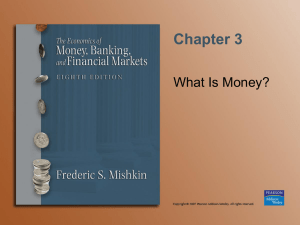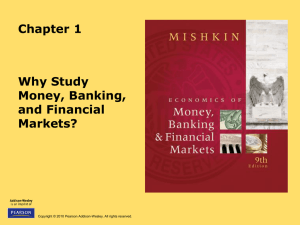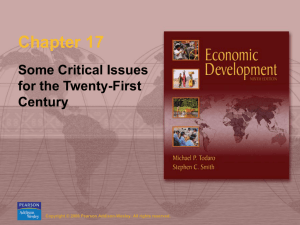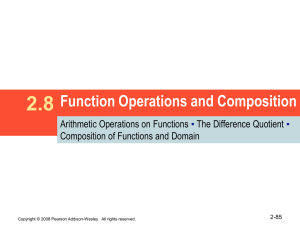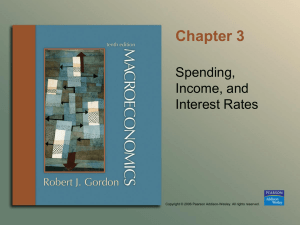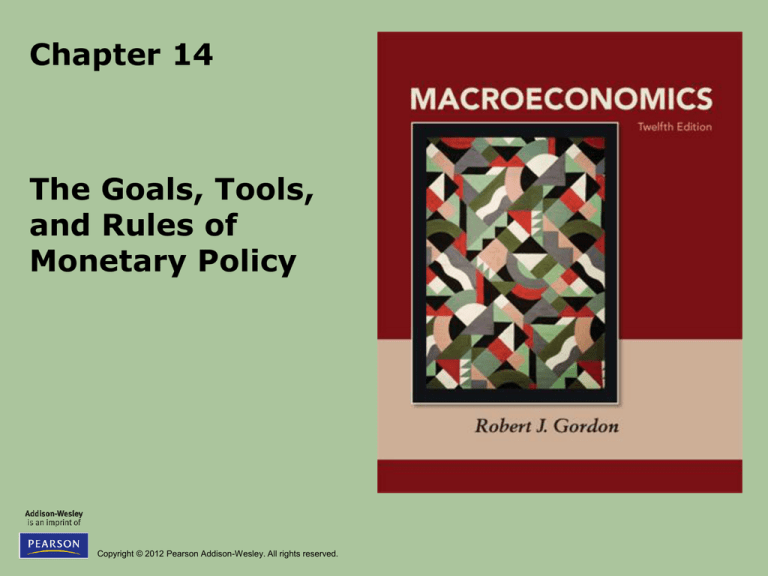
Chapter 14
The Goals, Tools,
and Rules of
Monetary Policy
Copyright © 2012 Pearson Addison-Wesley. All rights reserved.
Introduction to Stabilization Policies
• Stabilization policies aim at minimizing changes to real GDP
from exogenous Demand Shocks including:
– Changes in business and consumer optimism
– Changes in net exports
– Changes in government spending and/or taxes not related to
stabilization policy
•
Policy Activism purposefully changes the settings of
the instruments of monetary and fiscal policy to offset
changes in private sector spending.
– An alternate approach recommends Policy Rules that call for a
fixed path of a policy instrument like the money supply or a
target variable like inflation or unemployment.
Copyright © 2012 Pearson Addison-Wesley. All rights reserved.
14-2
Policy Rules and Monetary Policy
• In the 1930s, University of Chicago economist Henry Simons
posed a stark contrast between a totally discretionary
monetary policy and a fixed rule.
– A Discretionary Policy treats each macroeconomic episode as a
unique event without a common approach to all events.
– A Rigid Rule for policy sets a key policy instrument at a fixed
value.
• In the 1950s, Milton Friedman advocated a Constant Growth Rate
Rule (CGRR) that stipulated a fixed percentage growth rate for the
money supply. He was part of the Monetarism school of thought.
• A Feedback Rule sets stabilization policy to respond in a systematic
way to a macroeconomic event (e.g. the “Taylor” Rule)
Copyright © 2012 Pearson Addison-Wesley. All rights reserved.
14-3
Figure 14-1 A Flowchart Showing the
Relationship Between Policy Instruments,
Policy Targets, and Economic Welfare
Copyright © 2012 Pearson Addison-Wesley. All rights reserved.
14-4
The Rules vs. Activism Debate
• One way to distinguish between policy
activists vs. rules activists is their degree of
optimism of the self-correcting mechanism
of the economy vs. the efficacy of
stabilization policies:
Copyright © 2012 Pearson Addison-Wesley. All rights reserved.
14-5
The Positive Case for Rules
• Milton Freidman’s arguments for monetary policy
rules:
– A rule insulates the Fed from political pressure
– A rule allows the Fed’s performance to be judged
– A rule reduces uncertainty
• Weakness of these arguments:
– With no political pressure, Fed may accept too high U in
order to fight inflation
– The public may not care about the target variables chosen
by the Fed, and so may not care about the performance
and/or certainty of that variable
Copyright © 2012 Pearson Addison-Wesley. All rights reserved.
14-6
The Negative Case for Rules
• Rules are favorable to discretionary policies because
of the “long and variable” lags between changes in
monetary policy instruments and the ultimate
response of target variables like inflation and
unemployment.
• Five types of lags and their estimated duration:
Copyright © 2012 Pearson Addison-Wesley. All rights reserved.
14-7
Figure 14-2 The Percent Change in Real GDP
Following a 1 Percentage Point Change in the Federal
Funds Rate, Three Intervals, 1961–2010
Copyright © 2012 Pearson Addison-Wesley. All rights reserved.
14-8
Multiplier Uncertainty
• The multiplier formulas from Chapters 3 and 4
showed the size of the change in real GDP that
would result from a change in a policy
instrument.
• Dynamic Multipliers are the amount by which
output is raised during each of several time
periods after a given change in the policy
instrument.
• Multiplier Uncertainty concerns the lack of firm
knowledge regarding the change in output caused
by a change in a policy instrument.
Copyright © 2012 Pearson Addison-Wesley. All rights reserved.
14-9
Longer Lags and Smaller Multipliers
• Since the 1960s, lags have become longer and multipliers
have become smaller. Why?
– Housing sector has changed
• Financial deregulation has lessened the impact a rise in
interest rates have on housing, thereby blunting the force
of monetary policy
– More consumption financed by credit cards
• Credit card rates are not sensitive to changes in monetary
policy, thus dampening the effects of monetary policy on
consumption
– The adoption of flexible exchange rates in 1973
• Now monetary policy also affected exchange rates, and
therefore, after a long two-year lag, net exports
Copyright © 2012 Pearson Addison-Wesley. All rights reserved.
14-10
The Fed and “The Great Moderation”
• Why has there been a decline in economic volatility
since the mid-1980s?
– In other words, what caused “The Great Moderation?”
• Possibility 1: Smaller Demand and Supply Shocks
– Government military spending fell and was more stable
– Financial deregulation made residential construction less volatile
– Computers and improved management practices reduced the
volatility of inventory investment.
– The oil and farm prices shocks of the 1970s were absent in the
1980s.
• Possibility 2: Improved Federal Reserve
Performance
– The Fed moved rapidly and decisively in response to
movements in the log output ratio.
Copyright © 2012 Pearson Addison-Wesley. All rights reserved.
14-11
Figure 14-3 The Output Gap and the Moving
Average of its Absolute Value, 1960–2010
(1 of 2)
Copyright © 2012 Pearson Addison-Wesley. All rights reserved.
14-12
Figure 14-3 The Output Gap and the Moving
Average of its Absolute Value, 1960–2010
(2 of 2)
Copyright © 2012 Pearson Addison-Wesley. All rights reserved.
14-13
Figure 14-4 The Federal Funds Interest Rate
and the Log Output Ratio, 1980–2007
Copyright © 2012 Pearson Addison-Wesley. All rights reserved.
14-14
Time Inconsistency and Policy
Credibility
• Time Inconsistency describes the temptations of
policymakers to deviate from a policy after it is
announced and private decision-makers have
reacted to it.
• Policy Credibility is the belief by the public that
policymakers will actually carry out an
announced policy.
Copyright © 2012 Pearson Addison-Wesley. All rights reserved.
14-15
The Taylor Rule
• Stanford University economist John Taylor has
proposed a simple rule (called the Taylor Rule) for
the Fed to follow in setting the real federal funds
rate (rFF):
rFF = rFF* + a(p – p*) + b[ln(Y/YN)]
(where * represents the desired or target levels of variables
and a, b are parameters > 0)
– If the Fed cares about avoiding accelerating inflation, then
“a” is large.
– If the Fed cares about avoiding recession and/or high
unemployment, then it chooses a large “b.”
Copyright © 2012 Pearson Addison-Wesley. All rights reserved.
14-16
Figure 14-5 The Actual Federal Funds Rate
and Interest Rates Calculated by the Taylor
Rule, 1980–2010
Copyright © 2012 Pearson Addison-Wesley. All rights reserved.
14-17
Nominal GDP Rule
• A nominal anchor is a rule that sets a limit on the growth rate
of a nominal variable (like H, MS, P or PY)
– Goal is to prevent runaway inflation
• Recall: Growth rate for nominal GDP = p + y
• A nominal GDP rule limits p + y
– Main benefit is in response to supply shocks No response
necessary as p↑ offset by y↓
– Same as a Taylor rule that places equal weights on inflation and
real GDP growth
• Note: Taylor rule expressed in terms of inflation and level of real GDP
• In response to deep recessions, Taylor rule is more stimulative than
nominal GDP rule since output gap may be large even as y > 0
– Subject to forecasting errors and long implementation lags
Copyright © 2012 Pearson Addison-Wesley. All rights reserved.
14-18
Table 14-1 Assessing Alternative Policy
Rules (1 of 2)
Copyright © 2012 Pearson Addison-Wesley. All rights reserved.
14-19
Table 14-1 Assessing Alternative Policy
Rules (2 of 2)
Copyright © 2012 Pearson Addison-Wesley. All rights reserved.
14-20
The Debate About The Euro
• What are the benefits and costs of a single
currency for the EU?
• Benefits
– Elimination of costs and risks associated with exchange
rates improved intra-EU commerce
– Monetary and fiscal discipline lower inflation
• Costs
– No independent control over MS
– Prohibition of fiscal deficits over 3% limits automatic
stabilization during recessions
Copyright © 2012 Pearson Addison-Wesley. All rights reserved.
14-21
International Perspective
The Debate About the Euro
Copyright © 2012 Pearson Addison-Wesley. All rights reserved.
14-22
MS and Targeting Exchange Rates
• Under flexible exchange rates, an expansionary
monetary policy lowers interest rates, leading to a
depreciation that boosts NX and therefore output
• Under fixed exchange rates, monetary policy
must be used to maintain the fixed exchange rate,
and therefore is no longer available for stabilization
purposes
– This signals the central bank intention to keep inflation low
Copyright © 2012 Pearson Addison-Wesley. All rights reserved.
14-23

